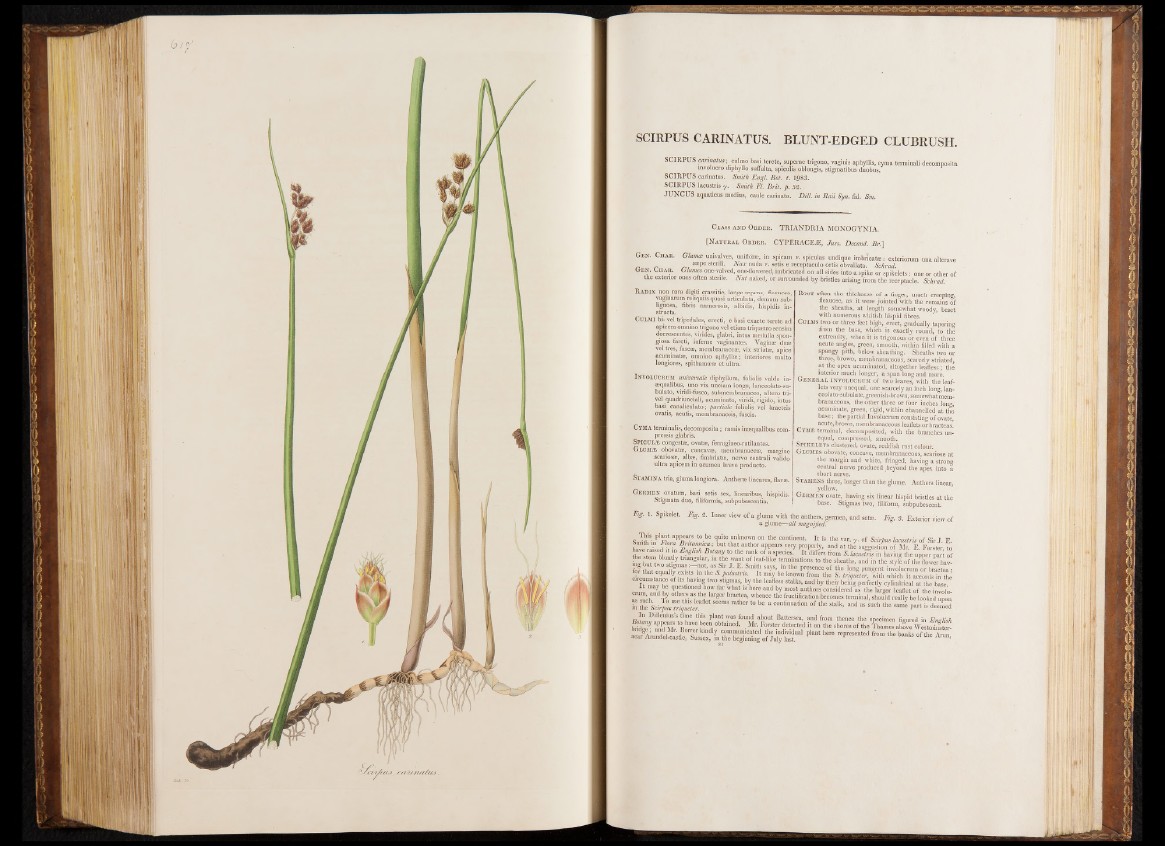
SCIRPUS CARINATUS. BLUNT-EDGED CLUBRUSH.
SCIRPUS carinatus ; culmo basi terete, supeme trigone, vaginis aphyllis, cyma termiimli decomposite
involucro diphyllo suffulta, spiculis oblongis, stigmatibus duobus.
SCIRPUS carinatus. Smith Engl. Bót. t. 1983.
SCIRPUS lacustris y . Smith Fl. Brit. p. 59.
JUNCUS aquaticus médius, caule carinato. Dill, in Raii Syn. fid. Sm.
Class and Ord e r . TRIANDRIA MONOGYNIA.
[N atural Ord er. CYPERACEiE, Juss. Decand. Br.]
Gen . Cha r. Glume unival ves, uni Bora, in spicam v. spiculas undique imbncatre: exteriorum una altentve
saspe stenli. Nux nuda v. setis e receptaculo ortis obvallata. Schrad.
OEN. Oha r. Glumes one-valvcd, one-flowered, imbricated on all sides into a spike or spikelets: one or other of
the extenor ones often sterile. Nut naked, or surrounded by bristles arising from the receptacle. Schrad.
Radix non raro digiti crassitie, longe repens, flexuosa, I
vaginarum reliquiis quasi articulata, demum sub-,
lignosa, fibris numerosis, albidis, hispidis in-
structa.
Culmi bi- vel tripedal es, erecti, e basi exacte terete ad
apicem omnino trigono.vel etiam triquetro sensim
decrescentes, virides, glabri, intus medulla spon-
giosa farcti, inferne vaginantes. Vagin« du«
vel tres, fuse«, membranace«, vix striat«, apice
acuminat«, omnino aphyll«; interiores multo
longiores, spitham«« et ultra.
I nvolucrum universale diphyllura, foliolis valde in-
«qualibus, urio vix unciam longo, lanceolato-su-
bulato, viridi-fusco, submembranaceo, altero tri-1
vel quadriunciali, acuminato, viridi, rigido, intus
basi canaliculate; partiale foliolis vel bracteis
ovatis, acutis, membranaceis, fuscis.
CrMA terminalis, decomposita; ramis inasqualibus com-
pressis glabris.
Spicul® congest«, ovat«, ferrugineo-rutilantes.
GlüM2E obovat«, concav«, membranace«, margine
scariosffi, alb«, fimbriat«, nervo centrali valido j
ultra apicem in acumen breve producto.
Stamina tria, glumalongiora. Anther« lineares, flav«.
Ge rmen ovatum, basi setis sex, linearibus, hispidis.
Stigmata duo, flliformia, subpubescentia.
Root often the thickness of a finger, much creeping,
flexuose, as it were jointed with the remains of
the sheaths, a t length somewhat woody, beset
with numerous whitish hispid fibres.
Culms two or three feet high, erect, gradually tapering
from the base, which is exactly round, to the
extremity, when it is trigonous or even of three
acute angles, green, smooth, within filled with a
spongy pith, below sheathing. Sheaths two or
three, brown, membranaceous, scarcely striated,
a t the apex acuminated, altogether leafless; the
! interior much longer, a span long and more.
Gen era l involucrum of two leaves, with the leaflets
very unequal, one scarcely an inch long, lanceolato
subulate,greenish-brown, somewhatmembranaceous,
the other three or four inches long,
acuminate, green, rigid, within channelled at the
base; the partial Involucrum consisting of ovate,
acute, brown, membranaceous leaflets or bracteas.
Cyme terminal, decomposited, with the branches unequal,
compressed, smooth.
Spikelets clustered, ovate, reddish rust colour.
G lumes obovate, concave, membranaceous, scariose at
the margin and white, fringed, having a strong
central nerve produced beyond the apex into a
short nerve.
Stamens three, longer than the glume. Anthers linear
yellow.
Germen ovate, having six linear hispid bristles at the
base. Stigmas two, filiform, subpubescent.
%■ '■ SPiMet- %■ 2- Inner view of a glume with the anthem, germen, and sehe. Mg. S. Exterior view of
a glume—all magnified.
This plant appears to be quite unknown on the continent. It is the var. y. of Scirbus lacustris of Sir J F
Smith in Flora Bntanmca; but that author appears very properly, and at the suggestion of Mr. E Forster to
H i » 11 i n Botany to the rank o f a species. It differs from S. lacusfris in having the upper part o f
i I S 2 3 S I P 5 ’ as Sir tT S I P ® *™ “ ations to the sheatlls> ™ the style of the flower hav- two s;^ma? — not, as Sir J. E. Smith says, in the presence of the long pungent involucrum or bractea •
mthar equally ex'stx in the S. palmlns. It may be known from the S. triqueter, with which it accords in the
It 0f lls1.havl”S[ twoshgmaa,by-the leafless stalks, and by their being perfectly cylindrical at the base
emm ? a questioned how far what is here and by most authors considered as the larger leaflet of the involii-
“ d oth“ jf. “ th„e larSer hractea, whence the fructification becomes terminal, should really be looked upon
in the S c i , ^ “ °/pn<cr SeB" S rathw ‘° bo a cont“1™ti™ <=f the stalk, and as such the same part is deemed
In Dillenius s time this plant was found about Battersea, and from thence the specimen figured in Enelish
b S - and1’Mr Borarer k i„ T . Mt. Forster detected it on the shores of the Thames above W estminltS
“ d Mr Borrer kindly communicated the individual plant here represented from the banks of the Arun.
near Arundel-castle, Sussex, in the beginning of July last. 9 ^